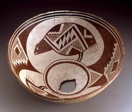
[Expect
a more in-depth article to appear here soon.]
Examples:

Mogollon culture, southwestern New Mexico,
Mimbres River Valley, Mimbres Bowl, 1000-1150 CE,
Mimbres classic black-on-white style II, painted earthenware,
height 4 3/4 inches (12.1 cm), diameter 11 1/4 inches (28.6 cm),
Museum of Fine Arts, Boston. Represented in this design are geometric shapes including an image of a quail.
Four Bears, also known as Mató-Tópe (Mandan, c.1795-1837), Battle with a Cheyanne Chief, 1833, watercolor and pencil on paper, 12 3/8 x 15 3/8 inches, Joslyn Art Museum, NB.

United States, Arizona, Navajo peoples, Wearing Blanket, 1860-70, wool weaving, 69 x
48 inches (175.3 x 121.9 cm), Metropolitan Museum of Art, NY.

Zuni
Pueblo, New Mexico, Water Jar (Olla), c. 1875, earthenware, white slip,
pigments, 11 1/2 x
13 11/16 inches, (29.2 x 34.7 cm), Cincinnati Art Museum, OH.

Probably Nakota, Yankton Sioux, Northern Plains, Shield, late nineteenth
century, buffalo rawhide, native tanned leather, calico cloth, hawk feathers,
pigment, diameter
20 1/16 inches (51.0 cm), Cincinnati Art Museum, OH.

Silver Horn (American, Haungooah), and other, unknown
artists, Kiowa, Plains, Silver Horn Target Record Book, 1890s,
drawings on 119 leaves of a bound record book -- a book intended
to be used for recording Army target-practice sessions; National
Anthropological Archives, Smithsonian Institution, Washington,
DC. Drawings include scenes of warfare, courting, personal dress,
the Sun Dance, and stories of the mythical trickster figure,
Saynday. At the end of the volume is a 30-page pictorial diary.
The drawings were made while Silver Horn was enlisted in Troop
L of the 7th Cavalry, based at Fort Sill, Indian Territory (now
Oklahoma). See other Kiowa drawings.
![]()
A'ani/Nakoda (American, Gros Ventre/Assiniboine; Montana,
Fort Belknap Indian Reservation), Pair of moccasins, c. 1880-1910, animal
hide, beads, 4 1/8 x 4 7/16 x 11 7/8 inches (each), Minneapolis
Institute of Arts. See leather.
Pueblo people (San Ildefonso Pueblo, New Mexico), Toña Peña Vigil (dates unknown, still active in 1915), or Martina Vigil (1856-1916) and Florentino Montoya (1858-1918) 1890-95, Storage Jar, fired clay and slip, 15 x 17 1/4 x 17 1/4 inches, Birmingham Museum of Art.

Julian Martinez (American, San Ildefonso Pueblo, New
Mexico, 1885-1943), Avanyu, c. 1923, Smithsonian American
Art Museum, Wasington, DC.

María Martinez and Julian Martinez,
Plate, c. 1930s, ceramic
blackware, 1 7/8 x 14 5/8 inches diameter
(4.8 x 37.2 cm), Smithsonian American Art Museum, Washington,
DC.
Tonita Peña/Quah Ah (American, San Ildefonso Pueblo, New Mexico, 1895-1949)
Abel Sanchez (American, San Ildefonso Pueblo, New Mexico, 1899-1971)
Fred Kabotie (American, Hopi, 1900-1986). Kabotie was one of numerous Indian artists to study with Dorothy Dunn at the Santa Fe Indian School.

Lucy M. Lewis (American, Acoma Pueblo, New Mexico,
1902-1992), Bowl, c. 1960-1965, Smithsonian American
Art Museum, Washington, DC.

Lucy M. Lewis, Jar, 1983, earthenware, 9 1/2 x 12 inches, National Museum
of Women in the Arts, Washington D.C.
Ma-Pe-Wi (American, Zia Pueblo, New Mexico, 1902-1973)
Margaret Tafoya (American Indian, 1904-), Jar, c. 1965, blackware, 17 x 13 inches, National Museum of Women in the Arts, Washington, DC.
Acee Blue Eagle (American, Creek/Pawnee, 1907-1959)
Woodrow Wilson "Woody" Crumbo (American, Creek/Potawatomi, 1912-1989)
Allan Houser (American, Chiricahua Apache, 1915-1994), The Wild Horses, 1953, watercolor, Heard Museum, Phoenix, AZ. Houser was a student at the Santa Fe Indian School with Dorothy Dunn.
Oscar Howe (American, Yanktonai Sioux, 1915-1983), Ghost Dance, 1960, watercolor, Heard Museum, Phoenix, AZ. Margaret Archuleta and others at the Heard Museum have written that "In the 1950s, many Native American artists abandoned Traditional Indian Painting and began to develop a style of painting that adopted modernist movements such as Cubism and Abstract Expressionism as vehicles for expression of Indian cosmology. This new approach to Indian painting was referred to as 'Non-Traditional Styles of Indian Painting' in the 1959 Philbrook Art Center's annual Indian painting show. It soon became known as New Indian Painting." Oscar Howe is considered one of the most important in this group, Ghost Dance having been influenced by Color Field painting. Oscar Howe became one of the many American Indians pushing against what some call the buckskin ceiling. See dance.
Harrison Begay (American, 1917), Navajo, Untitled (Scene from Enemyway Ceremony), c. 1960, tempera on paper, 22 3/8 x 30 1/2 inches, Joslyn Art Museum, NB.

Wayne Eagleboy (American, contemporary), We the People, 1971, Art Wagon Gallery. Contemporary Native American Wayne Eagleboy's version of the US flag bears portraits of two Indian men behind a screen of barbed-wire. The painting is framed with fur.

Jaune Quick-To-See Smith (American, Salish/Cree/Shoshone, 1940-), Famous Names, 1998, oil, acrylic, collaged photographs and mixed media on canvas, 80 x 50 inches (203.2 cm x 127 cm), Memorial Art Gallery of the U of Rochester, NY. See feminism and feminist art.
Arthur Amiotte (American, 1942-), Oglala Lakota (Sioux), Ascent of the Maiden, 1964, casein (tempera) on paper, 23 x 17 in.; 58.42 x 43.18 cm, Joslyn Art Museum, NB.
Bob Haozous (American, Chiricahua Apache/Navajo/English/Spanish,
1943-), Portable Pueblo, 1988, steel, 94 x 101 x 33 inches, Joslyn Art Museum, NB.
Pamela Shields (American, Blackfoot / Blood Band, contemporary), Blood, Rust, Hair, 1994, mixed-media photograph, 30 x 60 x 2 1/2 inches, Heard Museum, Phoenix, AZ.
Harry Fonseca (American, Maidu, contemporary)
Also see Australian Aboriginal art, archaeology, architecture, buckskin ceiling, Canadian art, ceramics, costume, design, drawing, ethnic, genre, jewelry, landscape, material culture, museum, narrative art, photography, portrait, Pre-Columbian art, sculpture, textile, vessel, and watercolor, among many other articles.
https://inform.quest/_art
Copyright © 1996-![]()